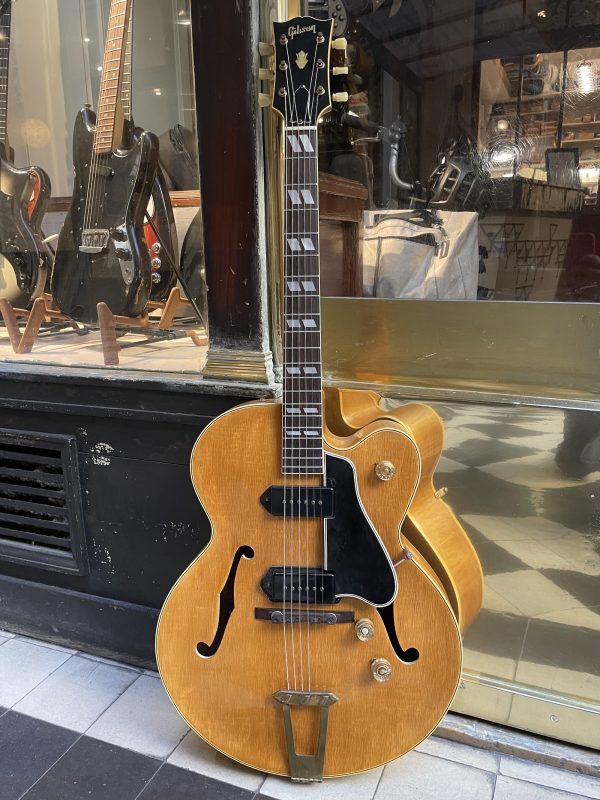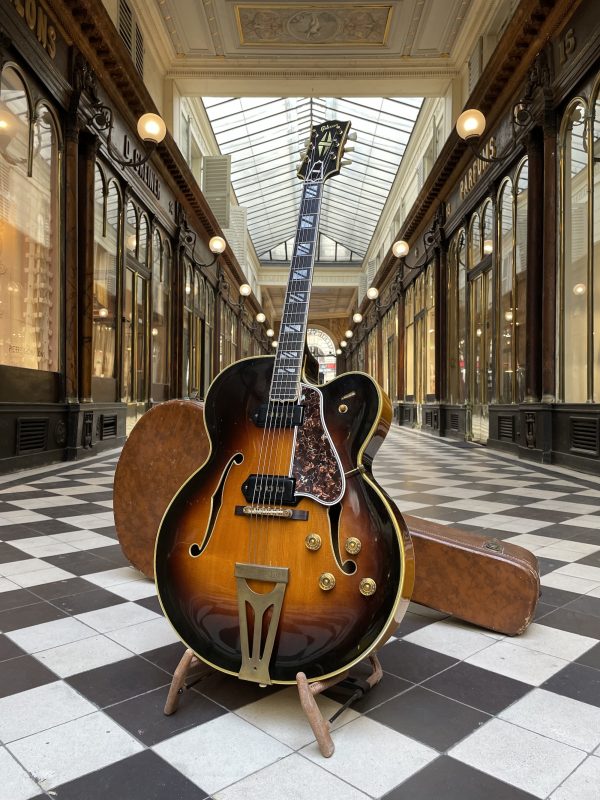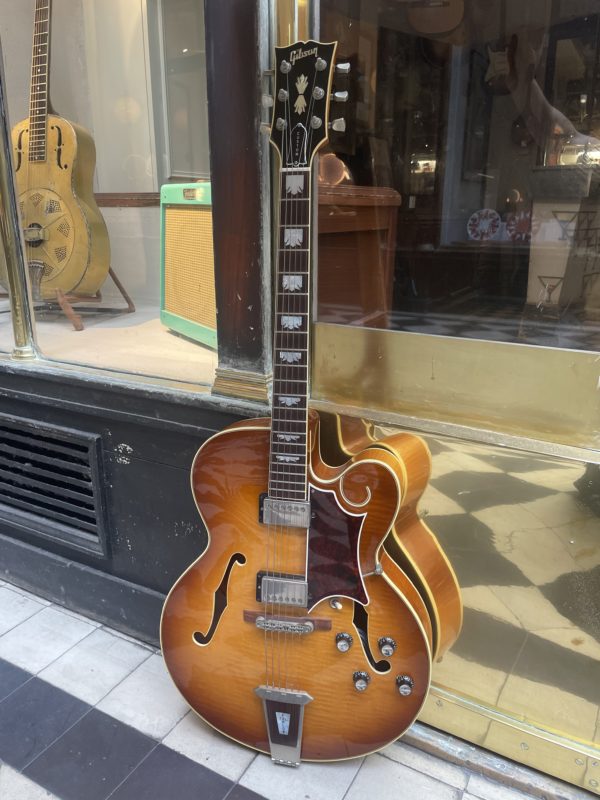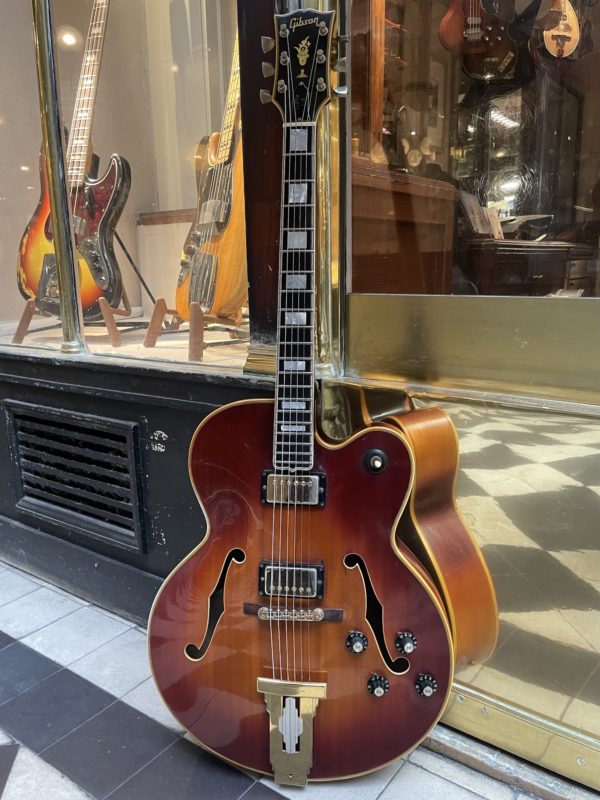Archtop (E)
1997 GIBSON TAL FARLOW CUSTOM
THE ARCHTOP GUITAR
The Anglo-Saxon term archtop denotes exclusively American-style jazz guitars. The term refers to the arched form of the guitar’s top, whether carved by hand or formed by heating a piece solid wood or plywood then moulding it into shape. The force of the mechanical constraint is such that it evokes the sturdiness, reliability and durability of the stone arches found in Roman-style architecture.
The concept of The Gibson, the very thing that prompted investors to capitalize from the beginning of the company in 1894 on the name of its inventor Orville Gibson (1856-1918), was initially based exclusively on carved top instruments, which were openly inspired by quartet instrument making. In the 1920s, Lloyd Loar (1879-1941) took over and developed this idea to completion. Thus, we see the emergence of a new kind of quartet formed by the mandolin, mandola, mandocello and mandobass, then guitars with tops and backs carved from a block of solid wood, exactly as one does for a violin, a viola, a cello and a double bass. A small detail nonetheless, mandolins and guitars are plucked string instruments and not bowed like the violin and cello. Does this mean that the concept developed by Orville Gibson and completed by Lloyd Loar defies the normal logic of instrument making? The question may be posed legitimately but considering the results, it is clear that there was a before and an after. The instruments that emerged as part of The Gibson are without a doubt made of different stuff than what had previously appeared in the history of the guitar. Lloyd Loar – whose whirlwind career at Gibson in the early 1920s would revolutionize the industry as a whole – was the one who pushed the inventions of Orville Gibson, who had passed away in 1918, to their limits by adding the f-holes typically found on classical instruments to mandolins and guitars instead of the traditional rosette.
The Gibson archtops were initially only made of solid wood, had a rosette sound hole and were, of course, purely acoustic – like the famous Gibson Style O model played by Big Bill Broonzy (1902-1958) for example, which was a unique instrument among those made before the Second World War as it received the very first cutaway in history! Then, after the passage of Lloyd Loar in the twenties, their aesthetic borrows from that of the cello with the appearance of soundholes or in the shape of an “F”, sometimes even the bracing, as can be seen on the most beautiful guitars of Elmer Stromberg ( 1906-1955), an exceptional luthier based in Boston. In the 1930s, the desire to increase the sound volume of the guitar led manufacturers to stretch the sides of the instrument to enlarge its body and thus its volume. Only here, once again, in terms of violin making, the reasoning which consists in associating a large sound volume with an imposing physical volume is a little bit trivial. Yet it was on this somewhat archaic train of thought that most steel-string guitar makers developed their instruments in the course of the 1930s. To be convinced of this, look no further than Prairie State or Euphonon models, whose proportions were close to those of a cello – many of these instruments achieved a beautiful and unprecedented balance between increased volume and timbre quality!
The era of so-called “robust” archtop guitars then came with the models that are still the most popular and copied today. Whatever the factors, they were almost all designed around the concept of the Gibson L-5, with the same type of top and bracing and only differing in proportion. The Epiphone guitar company, Gibson’s main competitor before being bought by it in the fifties, created such instruments of excellent craftsmanship – some people think that their archtops are much better in the pre-war period – in a more imposing format than the Gibson L-5. With the Epiphone Deluxe model and its 42.5 centimeters at the hips, we see the start of a hostile and unbridled race towards gigantism, a trend that will only truly end after the Second World War with the more systematic amplification of all guitars. However, it was Gibson who got the last word by imposing in 1934 the Super 400 model – 400 for four hundred dollars, an astronomical selling price for the time – with its 18 inches width at the lower bout.
Among the most popular robust archtops are those already mentioned by Elmer Stromberg with his Deluxe and Master 400 guitars; those of John D’Angelico (1905-1964) and his D’Angelico Excel and D’Angelico New-Yorker models, and the much later D’Aquisto New-Yorker and D’Aquisto Solo of made by D’Angelico’s brilliant apprentice Jimmy D’Aquisto (1935-1995). The instruments of these last three luthiers, all created on special order, bring together the specificities and intrinsic constants of high-end robust archtop guitars: extreme richness of rare wood, elegance of lines and impeccable finishes. Finally, it is interesting to note that Martin timidly tried its hand at making archtops for about ten years, starting in 1932. The few models offered were not successful with musicians, and none really came close to the robust format.
If we except a few cowboys and songsters who, like Johnny Cash’s mother-in-law Maybelle Carter (1909-1978), bought the most expensive guitar possible on the market, the archtop is strictly speaking a guitar meant for the jazz repertoire. Both intimate “chamber jazz” with the delicious virtuosos and pioneers Eddie Land (1926-1933), Karl Kress (1907-1905), Dick McDonough (1904-1938) and, in the orchestral genre, the magician Freddie Green (1911-1987), the most fantastic rhythm guitarist on earth with AC/DC’s Malcolm Young (1953-2017) in a whole different genre! Freddie Green ensured a rich rhythmic inversion of fabulous and complex chords, alive and fluid, in the orchestra of Count Basie (1904-1984). Throughout his career Freddie Green was faithful to the robust archtop, first the Epiphone Emperor models, and before his last Gretsch Eldorado model he used two Stromberg Master 400 models. Top of the class!





